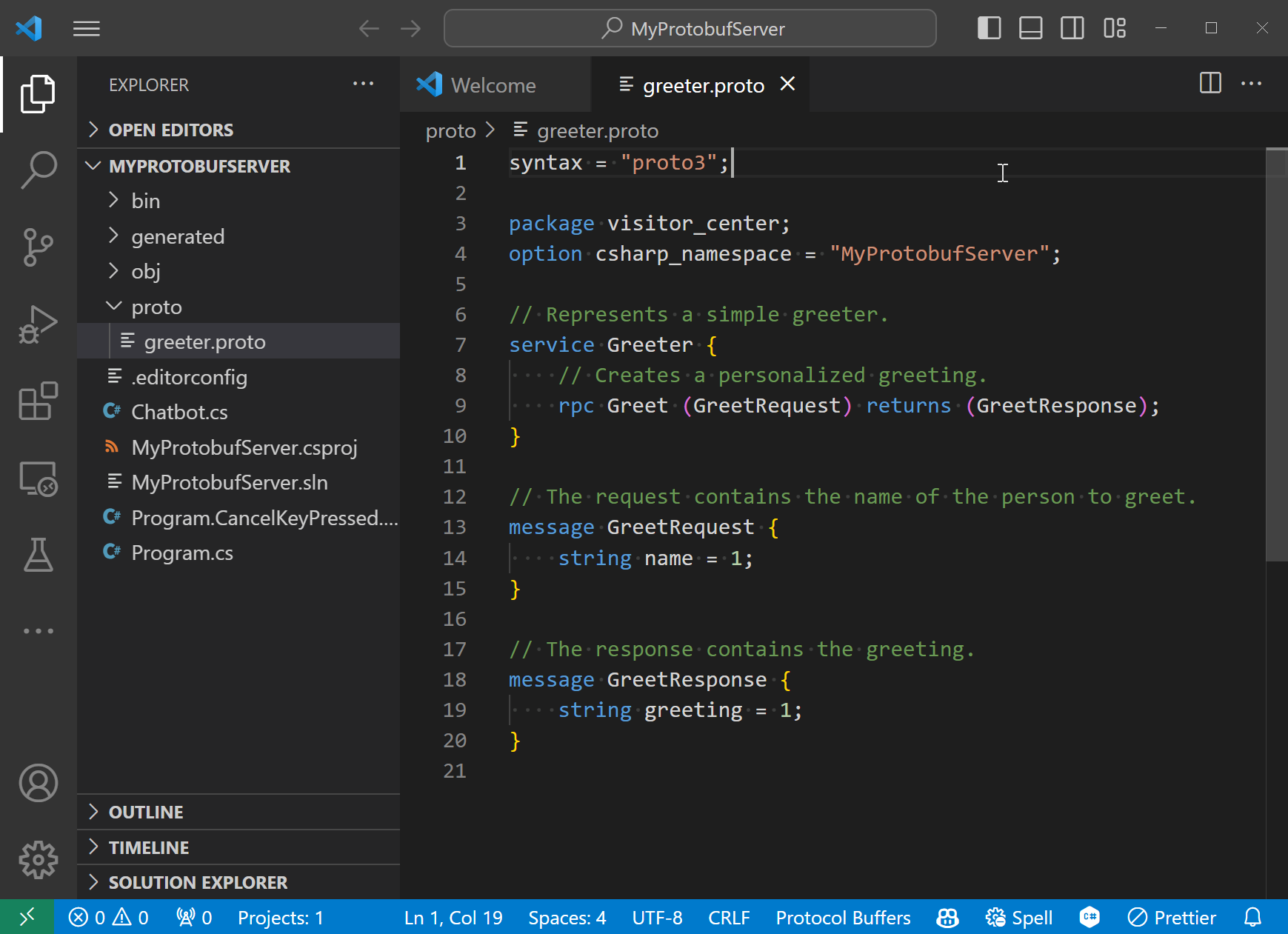Writing your first IceRPC + Protobuf server in C#
This tutorial is the first part of a two part series that shows how to create a complete application with IceRPC + Protobuf for C#. We start from scratch—you just need to have the .NET 10 SDK installed on your computer.
The networked application we are building together consists of:
- a server that hosts a single service (a simple greeter service)
- a client that establishes a connection to the server and calls
greeton this greeter service
The client and server are console applications that use plain .NET (no ASP.NET, no Dependency Injection).
The first part of this tutorial shows how to create the server. The second part shows how to create the client.
Let's jump right in:
Install the dotnet-new templates for IceRPC
dotnet new install IceRpc.TemplatesCreate the server
dotnet new icerpc-protobuf-server -o MyProtobufServerThis command creates a new IceRPC server application in directory MyProtobufServer.

Let's examine each file:
proto/greeter.proto - the contract
This file holds the contract between our client and server applications, specified with the Protobuf language.
It's a simple greeter:
syntax = "proto3";
package visitor_center;option csharp_namespace = "MyProtobufServer";
// Represents a simple greeter.service Greeter { // Creates a personalized greeting. rpc Greet (GreetRequest) returns (GreetResponse);}
// The request contains the name of the person to greet.message GreetRequest { string name = 1;}
// The response contains the greeting.message GreetResponse { string greeting = 1;}The csharp_namespace option instructs the protoc compiler to map package visitor_center to C# namespace MyProtobufServer (our project name) instead of the default (VisitorCenter).
If you use this code as the starting point for a new application, you should update this service to represent something meaningful for your application. For this tutorial, we just keep Greeter as-is.
Chatbot.cs - the service implementation
Class Chatbot is a service that implements Protobuf service Greeter:
[ProtobufService]internal partial class Chatbot : IGreeterService{ public ValueTask<GreetResponse> GreetAsync( GreetRequest message, IFeatureCollection features, CancellationToken cancellationToken) { Console.WriteLine($"Dispatching Greet request {{ name = '{message.Name}' }}"); return new(new GreetResponse { Greeting = $"Hello, {message.Name}!" }); }}The protoc-gen-icerpc-csharp generator generates C# interface IGreeterService from Protobuf service Greeter. This C# interface is a template: we implement Greeter by implementing this interface. As you can see above, the Greet operation becomes a GreetAsync method with two additional parameters.
Since we always fulfill Greet synchronously, the GreetAsync implementation is not marked async. We could write the return statement as:
return new ValueTask<GreetResponse>( new GreetResponse { Greeting = $"Hello, {message.Name}!" });However, it's more convenient to omit the type name, especially when this type is complicated.
We mark class Chatbot as partial because the ProtobufService attribute instructs the Protobuf Service source generator to implement interface IDispatcher—in other words, make Chatbot an IceRPC service implementation.
Program.cs - the dispatch pipeline and the server logic
The main program starts by creating and configuring a Router:
// Create a simple console logger factory and configure the log level for category IceRpc.using ILoggerFactory loggerFactory = LoggerFactory.Create(builder => builder .AddSimpleConsole() .AddFilter("IceRpc", LogLevel.Information));
Router router = new Router() .UseLogger(loggerFactory) .UseDeadline() .Map<IGreeterService>(new Chatbot());This router corresponds to our dispatch pipeline: when we receive a request, we first give it to the Logger middleware, then to the Deadline middleware and finally we route this request based on its path.
The Map call means if the request's path is the default service path for Slice interface Greeter, route it to the Chatbot instance. Otherwise, the router returns a response with status code NotFound.
The default service path for Greeter is /visitor_center.Greeter (it uses the Protobuf package name and service name). The Map call above is a shortcut for:
.Map("/visitor_center.Greeter", new Chatbot());The main program then creates a Server that directs all incoming requests to router:
var sslServerAuthenticationOptions = new SslServerAuthenticationOptions{ ServerCertificateContext = SslStreamCertificateContext.Create( X509CertificateLoader.LoadPkcs12FromFile( "certs/server.p12", password: null, keyStorageFlags: X509KeyStorageFlags.Exportable), additionalCertificates: null)};
await using var server = new Server( dispatcher: router, serverAuthenticationOptions, logger: loggerFactory.CreateLogger<Server>());We don't specify a server address so this server uses the default server address (icerpc://[::0]). This means the new server uses the icerpc protocol and will listen for connections on all network interfaces with the default port for icerpc (4062).
We don't specify a transport either so we use the default multiplexed transport (tcp). Setting the serverAuthenticationOptions means this server will only accept secure SSL connections.
At this point, the server is created but is not doing anything yet. A client attempting to connect would get a "connection refused" error.
The server starts listening on the next line:
server.Listen();Listen returns as soon as the server is listening (so almost immediately).
The main program then awaits until it receives a Ctrl+C. After it receives Ctrl+C, it shuts down the server gracefully:
await CancelKeyPressed;await server.ShutdownAsync();Program.CancelKeyPressed.cs - small Ctrl+C helper
This file contains a few lines of code that Programs.cs uses to wait for Ctrl+C. It's not related to RPCs.
MyProtobufServer.csproj - the project file
The project file is straightforward. It contains references to the required IceRpc NuGet packages:
- IceRpc.Protobuf - the IceRPC + Protobuf integration package
- IceRpc.Protobuf.Tools - the package that compiles
greeter.protointogenerated/Greeter.csandgenerated/Greeter.IceRpc.cs - IceRpc.Deadline and IceRpc.Logger - the packages with the two middleware we installed in the dispatch pipeline
Run the application
Start the server
cd MyProtobufServerdotnet runThe server is now listening for new connections from clients.
Shutdown the server
Press Ctrl+C on the server console to shut it down.